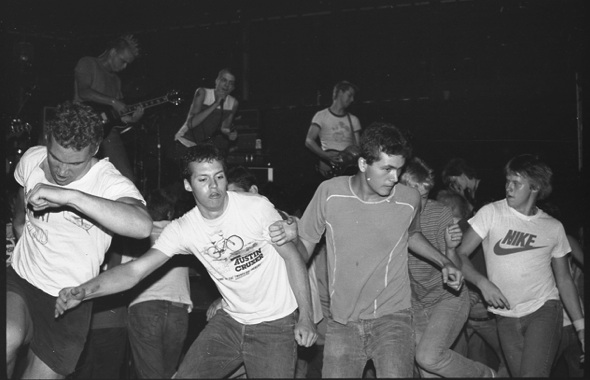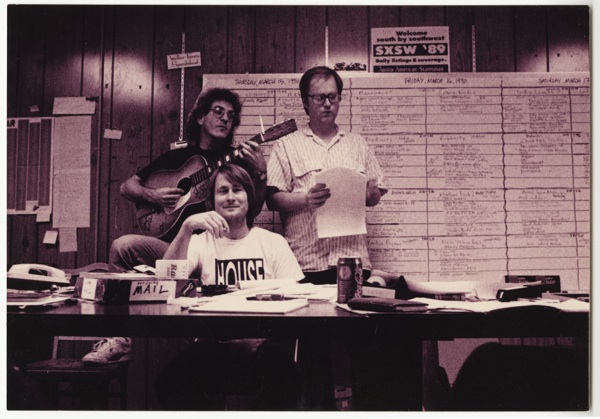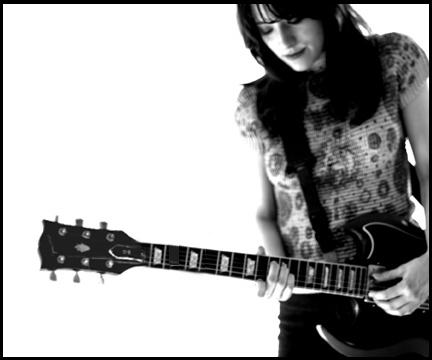
Austin, 1987. Photo credit Dixon E. Coulbourn
Videos by American Songwriter
Outside Industry: The Story of SXSW, a new documentary, opens with black and white footage of Austin in the years prior to 1987. Alan Berg, who directed the film, says he and his team found the footage from the cinematographer Lee Daniels (Slacker, Dazed And Confused). “That’s Lee going out in 1983 with a Super 8 shooting silent footage of punk shows around town,” says Berg. “That footage just sets the scene from Austin in the early ’80s.”
Berg, an Austinite and founder of Arts+Labor, who produced the film, is a journalist who spent 15 years as a political reporter. He first documented South By Southwest in 1994 with the short film, “South by Southwest: The Business of Music,” which won a local Emmy. From 1994 to 1999, Berg and his team were invited by SXSW’s founder Roland Swenson to document the festival. This past August, they decided to cull their efforts with footage collected from the Austin History Center and South By Southwest’s archives, and also tracked down footage from far and wide. It tells not only the story of the festival’s four founders – Roland Swenson, Louis Black, Nick Barbaro, and Louis Jay Meyers – but also the story of Austin over the festival’s 25 year history. We spoke to the Berg about making the film and its impact.
How did the scope of Outside Industry develop?
Initially we were thinking we’d cover that mid to late-’90s period – between about ‘94 and ‘99. Film and Interactive started in ‘94. Louis Jay Meyers left in ‘94. A lot of decisions were made about allowing labels to sponsor nights as opposed to everyone going through the jury process. Looking at that, I thought why don’t we do the whole run of the festival. Beginnings to end.
The film shows a nasty side of SXSW. Working with the blessing of the official SXSW organization, was it difficult to show all that?
I told Roland [Swenson] up front that if we were going to do this, we gotta have editorial independence from South By Southwest. It’s not gonna do any good if it’s perceived as a vanity piece. It’s got to be an independent journalistic enterprise. And because Roland’s a former journalist, and Nick and Louis run a paper, I think they got it. I held my breath. We interviewed people including Louis Jay Meyers who are polite on the surface, but there are feelings. We looked at the wristband controversy. We looked at day parties. I was a little nervous about their reaction. But they didn’t ask me to do anything when I showed them the rough cut. Which I thought was cool.

An early photo of Louis Jay Meyers, Brent Grulke and Roland Swenson.
How much is the original mission of connecting outsiders with music industry insiders still intact today at SXSW?
There’s essentially two South Bys now. All these independent bands come down here and play these different showcases and are networking. In that way it’s remarkably similar to what it was in ‘87. Because they’re just trying to get some notice. In ‘87 the mainstream press was ignoring South By so the Austin Chronicle leveraged their relationship with other alternative weeklies. Now the mainstream press is covering the big Goliath event. But you have all these day parties and showcases and every blogger and micro-site are tweeting out of here. So they are doing the same thing with new media what bands in ‘87 were doing with the old media.
How did you trace the origins of South By Southwest in the film? On a big-picture level, why did the festival happen?
There are a few key things. There was some fatigue over the New Music Seminar. People were tired of it. So here comes this event and it’s spring and suddenly it’s 75 degrees. Second, when it started they deliberately did it on Spring Break so the town would be empty. And the clubs needed an event [to bring people in] while the students were gone. All these executives can come down here and walk up and down 6th Street to this cluster of clubs. That really lays the foundation. The other thing I think is real critical to the success, The Austin Chronicle went out to 11 alternative weeklies and had each of those sponsor a band in their city come to town. They got bands coming from outside of central Texas and they got coverage. Over the course of three or four years you have this remarkable press engine that’s built up talking about this event. Then when New Music Seminar fell apart, South By was defaulted into its preeminence.
Is there one piece of footage or part of the film that you really enjoyed finding?
One of their pivotal years was ‘91. There was a lot of angst. That’s when they started getting some pretty serious backlash. Because people couldn’t get into clubs with wristbands and they were pissed. Bands didn’t like where they were scheduled. At the end of that – sort of symbolic of that – somebody stacked a bunch of Chronicles up next to The Austin Chronicle headquarters and torched the place. Arson. Somebody told me they remembered seeing a tape of [local writer] Michael Corcoran wandering through the burned-out fire on acid. And it was hilarious. We talked to Corcoran and he was like, “Actually it was mushrooms.” So we find the gal who taped it. She still had that old VHS tape.
What do you think people’s reactions will be to the film?
That’s going to be really interesting to me. It’s hard to say. In Austin, the further you get from Austin, the hipper the event becomes. There are so many conflicted feelings locally. I think people are going to enjoy Mojo Nixon, who is hilarious. There are a lot of entertaining moments in the film. How are people going to see the four founders? They’ll love Nick Barbaro, they’ll probably like Louis [Black] and they’ll debate Roland [Swenson] at the coffee shop. Roland is very comfortable with who he is. In his view, he’s done what it takes to keep the festival together. I asked him about parasite crews, and he’s like, “We track these bars, we need to. New Music Seminar fell apart in two years because they didn’t control their bookings.” And he shrugged. It depends on how idealistic are you. South By today would not be what it was if Roland hadn’t pushed through his vision for what he wanted it to become. Something as basic as starting film and interactive. What do you think the event would be like if they hadn’t started Interactive and Film and were reliant on the record industry. People will debate all that. But that’s what I want. For people to talk about what they saw.
 Outside Industry: The Story of SXSW will have its world premiere in Austin on Wednesday, March 16, at 4:30 p.m. at The Paramount Theater. For more info and ticketing, go here.
Outside Industry: The Story of SXSW will have its world premiere in Austin on Wednesday, March 16, at 4:30 p.m. at The Paramount Theater. For more info and ticketing, go here.












Leave a Reply
Only members can comment. Become a member. Already a member? Log in.